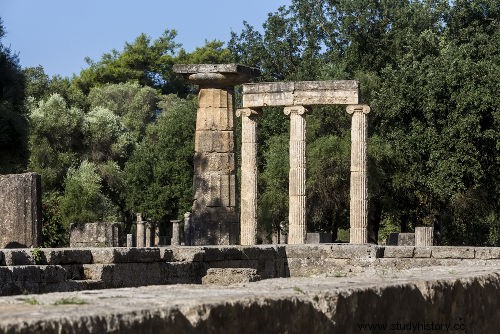
By Me. Cláudio Fernandes
The Olympic Games , or, as they are commonly called, the Olympics, had their origin around the second half of the 8th century BC, in the ancient Greek civilization. These games were associated with religious cults dedicated to the god Zeus.
The main Greek myth that narrates the origin of the Olympic Games in Greece is that of the twelve labors of Hercules (or Heracles). This hero, who was the son of Zeus with a human, to celebrate the completion of the sixth of his twelve labors (cleaning the stable of King Augeas of the city-state of Elis), he inaugurated a festival of sports in the city of Olympia. Of course, this story involving the character Hercules did not actually happen, as it is part of Greek mythology. However, it is known that sports games in the classical period of ancient Greece were actually held in Olympia as a form of tribute to Zeus, that is, history really proves that both sports games and the religious rituals associated with them took place in this city.

Ruins of the city of Olympia, Greece, where the ancient sports games were held
-
Walking races
Athletics is one of the most outstanding disciplines in the current Olympic Games and has typical characteristics, such as the 100-meter race and the obstacle course race. In Ancient Greece, there was also a similar modality, but with peculiar characteristics. According to research on the website “The Olympic Games in Ancient Greece”, coordinated by researchers Maria Celeste Cansolin Dezotti and Jame Kelly de Oliveira, foot races (called drómos ) were divided into at least five modalities:
1) stadion: it consisted of the normal sprint race and was performed around the Olympia stadium, which measured about 192 meters; 2) diaulos: it was the same kind of race as the stadion, but done twice; 3) dólikhos: it was also a race that covered the perimeter of the stadium, whose execution of the course could vary from 7 to 24 times, reaching approximately 4,000 meters. 4) hoplitodromia: race with a soldier's armament and armor (hoplite), i.e. helmet, shield, leggings, sword, etc. Finally 5), lampadedromía , which consisted of running with a lit torch that was rotated with other athletes from the same team, similar to the current races with baton relay.
-
Car Racing
The car races of the ancient Olympics must be understood as cars pulled by animal traction, specifically by horses, which were animals widely used in war. There were two forms of cars that competed in the races:the chariots , pulled by two horses, and the quadrigas , pulled by four. Horse-drawn car racing was done over long, sometimes steep, distances that required good equipment and horses. For these reasons, they were generally practiced by wealthy citizens of Greek city-states.
-
Pentathlon
O pentathlon (pentathlon, currently) was performed in a single event, but which involved five sports:the jumping , the launch of disk and from dart , the race and the fight. According to information from researchers Maria Celeste Cansolin Dezotti and Jame Kelly de Oliveira, jumping and discus throwing could be replaced by boxing and the pankration – which will be explained below).
-
Tosses and Jumps
The throwing (or throwing) of the discus, known as diskos , is also a very old modality, which precedes the Olympia games. As at present, the athlete had to throw the discs (at the time made of stone or polished metal, weighing about 5 kilos) at a minimum distance stipulated. The dart throw, called akón , also present in current games, derived from the practice of using the spear in hunting and in wars. The athlete had to throw the javelin (whose length reached 1.70 meters) in the center of a circle, drawn on the ground, at a considerable distance. As for the long jumps, which were then called pédema , there were also procedures similar to what happens in the current modality of this type of sport:the athletes had to perform the jump as far as possible, using the propulsion that was gained by running, before the altar.
-
Fights
Among the fights practiced in the ancient Olympic Games were the pale , the pýgme (or pygmachia ) and pancracy. The pale consisted of fighting without direct blows, such as punches and kicks. Athletes used strength measurement techniques, such as grasping the upper and lower limbs, with the objective of taking the opponent to the ground. The opponent's submission consisted of making him touch his shoulders to the ground and, with that, losing the contest. The pýgme consisted of the boxing , that is, fist fighting, similar to current boxing. Boxing is one of the oldest fighting practices. Among the Greeks, he is associated with the myth of Theseus , who killed the Minotaur on the island of Crete. The pancrazio can be compared not with a current Olympic sport, but with the mixture of several of them that makes up MMA (Mixed martial arts – Mixed martial arts ). Similar to MMA, or wrestling, the pankrácio was a very violent contact fight, which included punches, kicks, elbows, knees, twists, takedowns, headbutts, etc.
-
Olympic Games Rescue
In the old Olympic Games, other sports that, today, are also included in the Olympic modalities, such as equestrian , were also practiced. It is worth mentioning that nowadays the Olympic Games are very different from when they were practiced in ancient Greece. The person responsible for rescuing and rehabilitating the Olympics in contemporary times was the French aristocrat Pierre de Frédy (1863-1937), also known as Baron de Coubertin . Over time, sports from non-European traditions were included, such as the varied martial arts from the Far East and more recent sports, such as volleyball and football. Despite the obvious differences between the practice of games in antiquity and today, it is also interesting to note the similarities.
* Image credits:Schutterstock and Ververidis Vasilis
